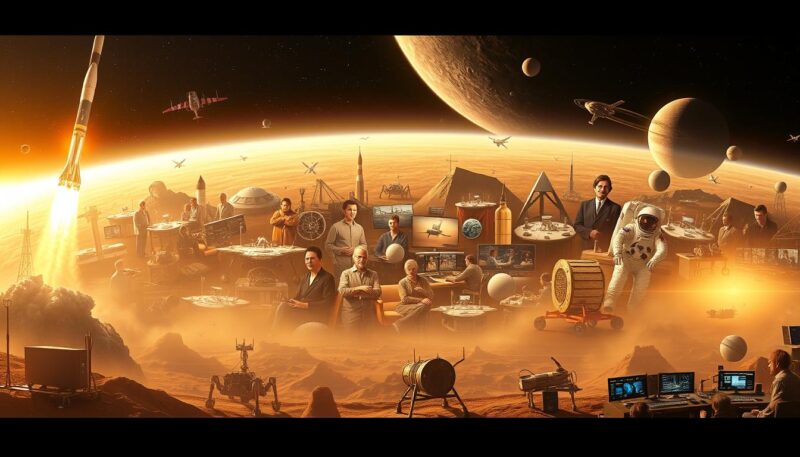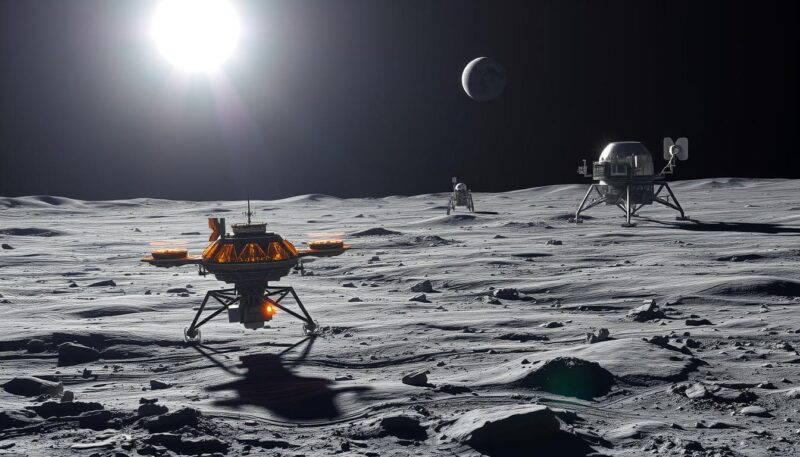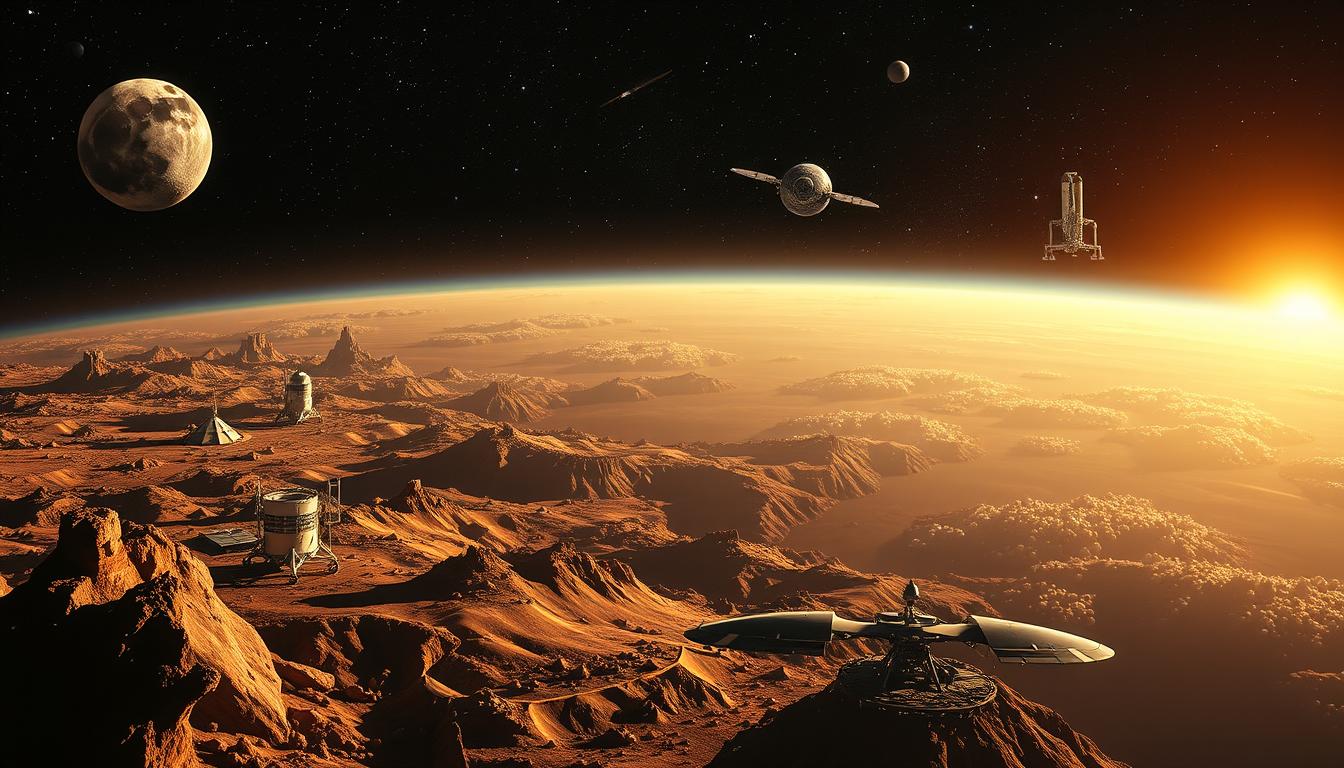As we stand on the brink of a new era in space exploration, it’s crucial to reflect on the significant milestones that have shaped humanity’s journey to the stars. From the groundbreaking achievements of the Space Race to the transformative collaborations aboard the International Space Station, each step has propelled our understanding and capability in the cosmos. The importance of these space exploration milestones cannot be understated, as they fuel our quest for knowledge and survival in an ever-changing universe.
In recent decades, we have witnessed extraordinary advancements, such as NASA’s Artemis program, which not only aims to land the next man and the first woman on the Moon, but has also attracted international cooperation—15 countries signed the Artemis Accords, highlighting our collective ambition for peaceful space exploration. Additionally, commercial partnerships are redefining the landscape of space travel, bringing in innovative technologies and fresh perspectives. These partnerships pave the way for a future rich with potential where the realms of space colonization and long-term human presence beyond Earth become more tangible possibilities.
The adventures that await us are not merely limited to feats of ambition; they are filled with pressing questions regarding humanity’s fate. Will we establish a sustained presence on Mars? What discoveries lie hidden in the depths of the outer planets? With the economic impact of NASA on the U.S. economy hitting a staggering $75.6 billion, the implications of space exploration extend far beyond science, influencing technology, education, and international relations. Join us as we delve deeper into the milestones accomplished in space exploration and explore what lies ahead in our unending quest for discovery.
Introduction to Space Exploration
The journey into the cosmos began centuries ago with early observations of celestial bodies. This introduction to space exploration highlights key moments that paved the way for modern advancements. In 1610, Galileo Galilei used the first telescope to observe the night sky, unveiling a universe beyond imagination. Isaac Newton’s creation of the first reflecting telescope in 1668 further propelled astronomical study.
Fast forward to the 20th century, the significance of space travel became apparent as theoretical foundations were laid by thinkers like Konstantin Tsiolkovsky in 1903. The launch of Sputnik 1 by the USSR in 1957 marked the dawn of artificial satellites, sparking a fierce competition in space exploration. This event underscored the importance of space travel as nations sought technological supremacy and scientific discovery.
Beyond national interests, the exploration benefits are manifold. Discoveries such as the planet Uranus by William Herschel in 1781 or the first soft landing on Venus by Venera 7 in 1970 have enriched our understanding of the universe. The advent of the International Space Station in 1998, representing cooperation between multiple nations, further illustrates how space exploration fosters collaboration and shared scientific progress.
Investment in space endeavors has led to groundbreaking technologies that find applications on Earth, impacting everyday life. Innovations in materials science, telecommunications, and environmental monitoring stem from the complexities involved in space travel. Thus, this exploration not only expands geographical frontiers but also enhances life on our home planet.
Key Space Exploration Milestones Throughout History
The journey of space exploration is marked by several key milestones that have defined our understanding of the cosmos. From the early days of the space race to the remarkable achievements of the Apollo program, these events not only showcase human ingenuity but also set the stage for future explorations.
From the Space Race to the Moon Landing
The historic space missions during the space race ignited global interest in space exploration. It began on October 4, 1957, when the Soviet Union launched Sputnik 1, the first artificial satellite, orbiting the Earth in just 98 minutes. This event initiated a competitive spirit that fueled numerous groundbreaking achievements.
On April 12, 1961, Yuri Gagarin made space race breakthroughs as the first human to venture into space aboard Vostok 1, completing a single orbit around Earth. Shortly after, on May 5, 1961, Alan Shepard became the first American in space with a brief 15-minute flight. The milestones continued with Valentina Tereshkova, who became the first woman in space in 1963.
The apex of this era was the Apollo program, particularly the Apollo 11 mission on July 20, 1969. This mission successfully landed the first humans on the Moon, with Neil Armstrong famously taking the first steps on the lunar surface. Between 1969 and 1972, a total of ten astronauts participated in lunar missions, solidifying the United States’ status as a leader in space exploration.
The Role of the International Space Station
The establishment of the International Space Station (ISS) marked a significant turning point in collaborative space research. Beginning its assembly in 2000, the ISS serves as a multinational laboratory for scientific experimentation and research in microgravity. This initiative reflects a commitment to not only exploring space but also fostering international cooperation in scientific endeavors.
The progress achieved through these historic space missions has laid the groundwork for future explorations, pushing the boundaries of human capabilities. The spirit of the original space race continues to inspire today’s advancements in technology and exploration, as humanity strives to reach new frontiers.

Recent Achievements in Space Travel
The landscape of space travel has transformed dramatically in recent years, marked by remarkable advancements and significant milestones. NASA’s Artemis Program stands at the forefront of this evolution, aiming to return humans to the Moon and set the stage for future deep space missions. Through this initiative, NASA endeavors to establish a sustainable presence on the lunar surface, an essential step toward exploring Mars and beyond.
NASA’s Artemis Program
NASA’s Artemis Program has already made considerable strides in lunar exploration. As part of its mission objectives, Artemis aims to land the first woman and the next man on the Moon by designing innovative spacecraft and technology. This endeavor emphasizes not only returning humans to lunar soil but also facilitating collaborative efforts with international and commercial partners.

The first mission, Artemis I, successfully tested the Space Launch System and the Orion spacecraft, promising exciting possibilities for future lunar missions. Continuing on this trajectory, Artemis II is set to include astronauts, taking them around the Moon and back to Earth, while Artemis III will focus on landing on the lunar surface.
Commercial Partnerships in Space Exploration
Commercial partnerships have become vital in advancing lunar exploration and deep space missions. SpaceX has contributed significantly to the record of 105 successful rocket launches from U.S. soil in 2023, reflecting a broader trend towards more accessible low-Earth orbit missions. This accessibility not only enhances satellite deployment but also encourages further exploration endeavors.
In a notable achievement, SpaceX’s Starship successfully executed its “chopsticks maneuver,” capturing the Super Heavy booster mid-descent. Such innovations illustrate the advancements in reusable rocketry, crucial for reducing costs and increasing mission frequency. Additionally, collaborations with other countries and companies, such as the Chang’e-6 mission’s successful return of lunar samples, parallel NASA’s efforts in pursuing comprehensive lunar studies.
These recent accomplishments underscore the momentum in space travel, bridging historical achievements with the promise of future explorations. Whether through entrenching a sustainable lunar presence or pursuing partnerships, the path forward looks bright as humanity reaches for the stars.
Significant Space Exploration Events Today
Recent advancements in space exploration have opened up new horizons for scientific understanding and curiosity. The James Webb Space Telescope has made groundbreaking contributions to astronomical research, fundamentally altering our view of the universe. Led by its high-resolution imaging capabilities, the telescope has unveiled a plethora of cosmic phenomena, offering insights into the formation and evolution of distant galaxies and planetary systems.
Discoveries Made by the James Webb Space Telescope
Among the myriad of James Webb Space Telescope discoveries, researchers have observed intricate details of star formation in distant galaxies. This has shed light on the life cycles of stars and the dynamics of their environments. The telescope’s infrared technology allows it to peer through cosmic dust, revealing hidden structures and providing crucial data on exoplanets, including atmospheric composition. These findings not only deepen our understanding of celestial mechanics but also pose questions that drive further astronomical research.
Upcoming Missions to Outer Planets
Looking ahead, significant missions are poised to expand our knowledge of outer planets. The SPHEREx mission aims to collect data on over 450 million galaxies and 100 million stars in the Milky Way, set to launch in February 2025. Similarly, NASA’s PUNCH mission will deploy a constellation of four satellites designed for 3D observations of the inner heliosphere. These initiatives promise to enhance our understanding of solar dynamics and planetary interactions within our solar system.
Such upcoming missions reflect a robust commitment to exploring cosmic phenomena, ensuring that humanity remains at the forefront of space exploration and discovery.
The Future of Space Exploration
As humanity looks towards the stars, the future of space exploration hinges on groundbreaking advancements in technology. Various technological innovations in space will pave the way for ambitious missions, expanding our reach beyond the Moon. Efforts to harness robotics in space exploration stand out, promising to enhance safety and efficiency in space missions. Improved propulsion systems, artificial intelligence, and innovative materials will facilitate longer, more complex missions, marking a significant shift in how we explore the cosmos.
Technological Innovations and Their Impact
The landscape of future space travel is expected to be revolutionized by several technological innovations. The development of advanced propulsion technologies could drastically reduce travel times to destinations like Mars, which currently requires extensive planning and resources. For instance, a three-year mission to Mars necessitates around 24,000 pounds of food alone, highlighting the need for more efficient supply chain solutions. Robotics in space exploration will play a crucial role in these endeavors, from preparing habitats for astronauts to conducting experiments in remote environments.
Preparing for Mars Colonization
As plans for Mars colonization evolve, space agencies around the world are ramping up their efforts. The Artemis program aims to establish a sustainable human presence on the Moon, serving as a stepping stone for missions to Mars. Proxima Centauri, the closest star system to our own, is a staggering 4.24 light years away, reminding us of the challenges that lie ahead. The anticipated advancements in technology will not only help us reach these distant destinations but also address resource utilization challenges during extended missions. Developing partnerships within the commercial sector, coupled with international cooperation, will be essential in overcoming the obstacles of future space travel.
Conclusion
As you reflect on the remarkable journey of space exploration, it is clear that the milestones achieved have immeasurably advanced your understanding of the universe and your capabilities as a species. From the inaugural launch of Sputnik in 1957 to the iconic Apollo 11 mission that placed humans on the Moon, each achievement has paved the way for the next steps in exploration. This legacy serves not just as a record of human ingenuity but as a stepping stone towards the future of humanity in space.
Ongoing space exploration initiatives, such as NASA’s Artemis Program and the pioneering work of the International Space Station, exemplify a commitment to collaboration and innovation. These efforts not only enhance your scientific knowledge but also foster a sense of global unity in the pursuit of exploring beyond your home planet. As you delve into the possibilities presented by missions like the James Webb Space Telescope, the promise of discovering more about exoplanets and potentialHabitability of distant worlds becomes increasingly tangible.
Looking forward, it is essential to embrace the spirit of inquiry and courage that has fueled space travel thus far. The next steps in exploration will involve surmounting challenges, both technical and ethical, as you prepare for ambitious missions, such as a potential Mars colonization. The journey into space promises unexpected wonders and invaluable insights that may ultimately determine the future of humanity in space, ensuring that you remain an integral part of the cosmos.
